Xbox One: Year One review – How is Microsoft's new console doing one year later?

On November 22, 2013 the Xbox One launched in the US and several other territories. The first new console from Microsoft in 8 years, the One was long overdue. But at launch, the Xbox One faced an uphill battle due to a series of PR blunders, poor pre-leadership from former Xbox chief Don Mattrick (who tellingly departed for Zynga in July that year), and a $100 price disadvantage against its competitor the Playstation 4.
In our comprehensive launch review, I praised the Xbox One as a games and entertainment machine, but criticized its underdeveloped user interface, social features, and other major and minor failings. Luckily, Microsoft has worked hard under new Xbox head Phil Spencer's leadership to improve the Xbox One in the first post-launch year. Now we're back with another massive review that looks at the console's many strides and areas that continue to need improvement.

Born with the Kinect around its neck
Several of the Xbox One's launch issues revolved around the inclusion of the Kinect 2.0, Microsoft's motion tracking peripheral. The new Kinect faced an uphill battle with gamers for numerous reasons.
For starters, Mattrick's Microsoft chose to only make the Xbox One available with the Kinect. You couldn't get a Kinect-less SKU initially. Even though the Xbox One and Playstation 4 have very similar architecture, the One cost $499 at launch, giving the Playstation 4 (which launched at $399) a huge price advantage.
Equally important, most core gamers simply did not want the Kinect and resented its inclusion. The original Kinect on Xbox 360 failed to impress, with only a few quality titles (such as the Dance Central series) to its name. Although the new Kinect boasts significantly improved camera resolution, motion detection, and voice command support, a great many gamers simply don't want to play games with motion controls.
Microsoft tied the Xbox One down with a casual gamer-focused peripheral despite the console's non-casual price and the fact that dedicated gamers tend to be early adopters, not casual ones.
The only possible way the company could have gotten gamers to accept the Kinect's inclusion would have been launching the system with an arsenal of extra-strong Kinect games that would sell players on the device's features. That would make sense, right?
Get the Windows Central Newsletter
All the latest news, reviews, and guides for Windows and Xbox diehards.

Zumba Fitness World Party
Damningly, Mattrick's regime utterly failed to fast-track Kinect game development for the new console. The system launched without a single first-party Kinect game ( Xbox Fitness is not really a game), and very limited third-party support: Just Dance 2014, Zumba Fitness World Party, and Ubisoft's awful The Fighter Within. If you didn't like Kinect games on the Xbox 360, no way would the Xbox One launch lineup win you over.
It's important to note that a fair number of early Xbox One adopters, including many of our readers, actually do enjoy the Kinect. They praise its voice commands, which make navigating the UI and media playback a unique and pleasurable experience compared to other platforms. It's great that people who gave the Kinect a chance (albeit largely for non-gaming purposes) feel favorably towards it, but they are the minority and couldn't boost the system's sales on their own.

Dance Central Spotlight
Disconnecting the Kinect
When Xbox One sales struggled against the Playstation 4, Microsoft moved surprisingly quickly and started offering Kinect-less Xbox One consoles in June of this year. This was met with gnashing of teeth from early adopters and the Kinect faithful. Heck, we even published an editorial complaining about the decision.
No matter whose hearts had to be broken to do it, making the Kinect an optional purchase was the right call. The Kinect-free Xbox One sells for $399, putting it on par with the Playstation 4 instead of at a disadvantage. And cutting the cord on Kinect has allowed Microsoft to slash the price of the console down to $349 for the holidays, making it an even better deal.
While it's true that developers can no longer count on each Xbox One owner having a Kinect, you have to keep in mind that almost no developers were developing Kinect games in the first place. But the Kinect software situation has slowly and surely picked up since last year's disastrously dry launch.
If you like weird and quirky games, you should own D4.
The following Kinect-intensive games are now available, with a few more indie titles on the way in the future:
- Dance Central Spotlight: the first must-have Xbox One Kinect game. Includes 10 songs with plenty more to buy.
- D4: Dark Dreams Don't Die: Although I much prefer D4 with a controller, some folks dig the game's Kinect controls.
- Fantasia: Music Evolved: A retail Disney-themed music title from Harmonix.
- Just Dance 2015: The annual retail competitor to Dance Central Spotlight.
- Kinect Sports Rivals: Hopefully the last misfire from Rare, now that Phil Spencer has changed their course back to core titles.
- Rabbids Invasion: The Interactive TV Show: I predict this will tank, but kids should enjoy it.
- Shape Up: A fairly creative fitness game from Ubisoft.
Far from a Kinect utopia, but people who dig motion controls still have a decent range of software to choose from.
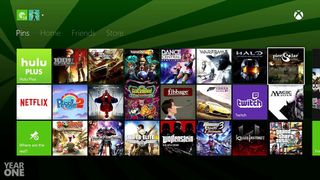
Dashboard, snapping, and more: the Xbox One user interface
The Xbox One inexplicably launched with an extremely rough user interface that abandoned many of the Xbox 360's UI strides and innovations. The familiar Guide button menu was gone, the boring black dashboard background couldn't be changed, many common functions like Messages and Settings were difficult to locate without the use of Kinect or required far too many steps to access, and app Snapping was both difficult and limited in usefulness.
On the plus side, the dashboard/home menu is dramatically faster than the Xbox 360 dashboard, and almost entirely free annoying advertisements. The ability to pin games and apps has been a welcome feature since launch, with users' pins following them to other consoles via the cloud.
Microsoft heard the user outcry over the rushed Xbox One UI loudly and clearly, rushing to release an OS update in December 2013 that mostly improved stability. A major update followed in February 2014 which added important features like keyboard support, a controller battery indicator, sorting of games and apps, the ability to delete games, and more. Games and Apps now appear in separate lists, as does the download queue, thank goodness.
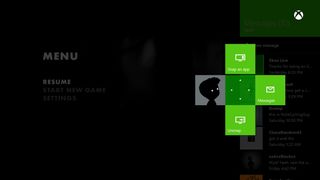
Xbox One Snap menu
The Xbox One OS has been updated every month since then, bringing more and more features and UI improvements. Just this month, we finally got the ability to set custom backgrounds. The method of doing so is quite unintuitive at present, but our custom background guide will point you in the right direction.
Snapping apps has also received a major overhaul, with users now able to snap conveniently by double-tapping the Home button on the controller. This brings up the Snap UI from which you can snap or unsnap apps as well as toggle control between the primary and snapped apps. I maintain that the View button on the controller should be assigned to that purpose, but double-tapping Home works well enough.

Pier Solar with Twitch snapped
Despite those numerous advancements, the Xbox One user interface hasn't been perfected just yet. We still can't jump to a game's Achievements from the Games menu. That should be an option in each game's Menu button-activated context menu. On the plus side, the Achievements app itself deep-links to the recently released TrueAchievements app. You can search for Achievement solutions directly from the main Achievements app, which is handy.
Some things that would be convenient pop-ups on 360 (like messages and Achievements) instead launch as either a snapped or full-screen app on Xbox One... Both usually prove less convenient than the Xbox 360 equivalent. We need the ability to control whether apps launch in snapped mode or not.
Hopefully those refinements and more will come in time. On the whole, Microsoft has done a great job of consistently updating and polishing the Xbox One OS and user interface.

Social features and parties
The Xbox One launched with a few social improvements over its predecessor, most notably the ability to have up to a thousand friends and to follow people who haven't added you to their friends lists. On the other hand, messaging, notifications, and especially parties were all significantly worse than on Xbox 360. So how have things progressed since then?
Happily, social stuff is largely up to snuff nowadays. Users can add friends to a favorites list and get notified when their favorites are online. You can also sort people by friends, favorites, followers, and (thank goodness) recent players. The new Friends Achievements leaderboard on the dashboard is pretty sweet too.
The Friends Feed displays more kinds of data than before and supports the ability to post status updates and comment on items, which is cool. I feel that it still needs more improvement before it becomes truly useful, however. It's still a bit too tucked away and easy to overlook or ignore.

Parties were a wreck at launch, with players often unable to communicate, and constant nags to join the other members' games if you weren't already in their games. The nags at least have been done away with. But it pains me to say that parties still don't work very well.
As recently as a week ago, I and my friends have experienced an issue in which some members of the party are unable to hear party chat or communicate with each other. We tried leaving and rejoining, etc. but sometimes the party app just doesn't want to let members communicate with each other. That is inexcusable, and Microsoft needs to make solving the issue a priority.

Media Player for Xbox One
Media playback
Another place the Xbox One started out behind the 360 is media playback. Streaming videos and music from a computer or other sources was all but impossible at launch. Savvy users had to make use of "Play To" commands on PC since the console itself had no streaming interface. Many forms of media couldn't be played back on the One at all.
The Xbox One is still a bit behind the Xbox 360 as far as streaming goes, but it has made big strides regardless. The Media Player app (released in September 2014 and subsequently updated multiple times) can stream videos, music, and pictures from a PC with speed and relative ease. It can also launch media directly from USB storage devices.

Killer Instinct with Media Player snapped
Media Player still has some room for improvement, which is to be expected. Music and videos can play while snapped, but you have to go full-screen to actually navigate folders and albums. A minor hassle, but many apps haven't been properly optimized for snap mode either. Also, music playback sometimes stops for no reason when it should move on to the next song.
More frustrating for me is the rudimentary MKV support. MKV is a popular video container that combines video, audio, subtitle files into a single file. A single MKV can hold multiple audio and subtitle tracks, instead of making users download or manage multiple files. MKVs are popular in the fansub scene, where translation groups add subtitles to programs that haven't been commercially released in the US or other territories.
Strangely, Media Player can only play MKV files from USB storage. Try to stream an MKV and the app simply won't see the file. Worse, even when playing MKVs from USB, the app doesn't support subtitles. That's the whole point of MKVs, so it might as well not even support them right now. Fingers crossed that Microsoft will improve Media Player's MKV support sooner rather than later.
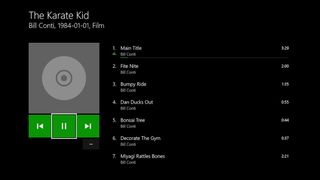
Xbox One CD Player app
Two areas of media playback in which the Xbox One continues to lag behind the Xbox 360 are CD support and custom soundtracks. CDs can be played from the optional CD Player app, but they can't be ripped to the console's hard drive as on 360.
Nor does the Xbox One support custom soundtracks, a staple feature of the original Xbox and Xbox 360. We can kinda-sorta approximate them by snapping the Media Player or CD Player apps and then turning off an individual game's music. But the snapped app would eat up screen real estate. The music would play even when it shouldn't, such as during cinematic sequences. Custom soundtracks were a great feature, and I hope they make their way to Xbox One someday.
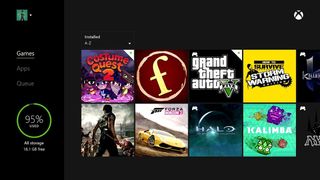
Storage and expansion
The Xbox One launched with a non-upgradable 500 GB internal hard drive, and most models still come equipped with the same size. The recently released Call of Duty: Advanced Warfare console bundle includes a 1 TB hard drive, but it sells for a whopping $100 more than the standard model.
The Xbox One requires all games to be installed to the hard drive before playing. Games are now much larger than in previous generations, with some titles like Halo: The Master Chief Collection taking up as much as 59 GB of storage. Thus Microsoft's decision to launch with and continue to include only a 500 GB drive in most Xbox Ones seems awfully shortsighted. Gamers will run short of room.

External hard drive support was promised but not ready at launch. Luckily, external drive support finally debuted in June. Gamers can connect up to two USB 3.0 external hard drives and choose to install games directly to either drive. Using an external drive actually improves installation and loading times to a small degree, making it an even better option over the internal drive. The Xbox One supports external drives of any size, so the only limited is how much you want to spend on a bigger drive.
Small internal drive aside, the ability to buy and use any USB 3.0 drive you want is extremely convenient and will keep even the most avid Xbox One gamers from running out of storage space in the long term.
We'll have a guide to installing and using an external drive up next week. You can preview the video portion of the guide on YouTube right now.
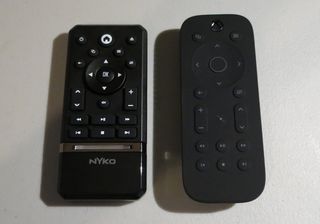
Nyko Media Remote and Xbox One Media Remote
Controllers and accessories
While we're on the subject of add-ons, let's examine the availability of controllers and accessories for Microsoft's latest console.
The Xbox One launched with a fairly cheap pack-in headset, but since then a lot of superior headset options have become available. The official Xbox One Stereo Headset launched in March alongside the Stereo Headset Adapter. The headset itself is great and comes bundled with the Adapter.
A variety of third-party headsets have launched for Xbox One as well, though they tend towards the pricier end of the spectrum. Like the official headset, they cover both ears and mix both chat and game audio. Most third-party headsets require the separate purchase of the Stereo Headset Adapter, which is an inconvenient (but one-time) additional purchase.
Sadly, Microsoft has yet to release a wireless headset for the Xbox One. The original Xbox 360 wireless headset was fantastic (the later Bluetooth model not so much). We can only hope the big MS gives us the same wireless option before the Xbox One turns two.
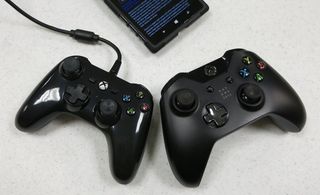
Power A Mini Series Controller and Xbox One Wireless Controller
Media playback enthusiasts have several remote controls to choose from. The official Xbox One Media Remote launched alongside the Stereo Headset in March, though supply problems limited its availability for a month or so after that. Third party remotes include the Nyko Media Remote (which I like better than Microsoft's version), as well as universal remotes from Inteset (review coming soon!) and Logitech.
In the realm of controllers, Microsoft has released colored variants for Titanfall, Call of Duty: Advanced Warfare, and both blue and green camouflage models. If those color choices don't suit you, both Color Ware and Controller Modz offer high quality custom controller designs.

Thrustmaster TX Racing Wheel for Xbox One
Gamers on a budget might want to consider third-party wired controllers. Power A makes both the Mini Series Controller and the Spectra Controller (review coming soon). PDP sells Rock Candy controllers in red, green, and blue (review coming soon).
Fighting game fans can pick up arcade sticks from Mad Catz and Razer, though both options ring up at a whopping $200. Racing enthusiasts have four wheels to choose from: two Thrustmaster Wheels ($99 and ~$299, review coming soon), a $400 Mad Catz wheel, and an $90 Hori wheel.
None of those third-party controllers, sticks, or wheels offers headset support. This appears to be a limitation imposed by Microsoft, not a cost cutting measure from the accessory manufacturers. Microsoft is seriously limiting the appeal of third-party products by preventing them from offering the basic and important option to support headsets. That said, players can work around the issue by chatting from an extra first-party controller (yes, it works).

Forza Horizon 2
Actually, it's all about the games
User interfaces, media playback, social features, and accessories: none of these would matter without games. The pre-launch leadership failed to appreciate that the Xbox One is primarily a gaming machine, poising the console for a rocky start with its core audience. Thankfully, Phil Spencer's regime has done its best to course correct since launch.
This year, the Xbox One has arguably bested the Playstation 4 in the all-important area of retail exclusives. The PS4's AAA exclusives of 2014 include: Infamous: Second Son, The Last of Us Remastered, Driveclub, and LittleBigPlanet 3. The Xbox One's Titanfall, Forza Horizon 2, Sunset Overdrive, and Halo: the Master Chief Collection. This year's Halo is a knockout for first-person shooter players, though its online mode didn't work at launch and still has some issues a few weeks later (not unlike Driveclub, which suffered broken multiplayer for weeks as well).

Halo: The Master Chief Collection
The Xbox One's retail launch lineup was quite strong as well, with Dead Rising 3, Forza Motorsport 5, and Ryse: Son of Rome each proving to be strong exclusives. All three have recently been bundled with their downloadable content as Game of the Year Editions, extending their shelf life.
Third-party retail support is going strong for Xbox One as well. Grand Theft Auto V, Dragon Age: Inquisition, The Evil Within, and Call of Duty: Advanced Warfare are just a few of the AAA third party titles that arrived on Microsoft's console (as well as Sony's) this fall.

Grand Theft Auto V for Xbox One
Every domestically released retail Xbox One game is also available as a digital purchase. Digital versions of retail games tend to retain their original prices even as retail versions drop in prices. They can't be resold, so you're generally stuck with them whether you like them or not.
Yet gamers who tend not to trade or sell their games (like me) will find the convenience of buying from anywhere and being able to play games without inserting discs worth the trade off. Digital preorders with preloading and preorder bonuses (all instituted fairly recently) make skipping retail an even more attractive option.

Never Alone
Downloadable games aplenty
Speaking of downloadable games, the anemic selection of digital-exclusive games at launch ( Crimson Dragon, Killer Instinct, LocoCycle, and Powerstar Golf) left many gamers wanting more. Since then, downloadable games have increased exponentially. Peggle 2 and Max: The Curse of Brotherhood were early standout titles. Minecraft: Xbox One Edition, D4: Dark Dreams Don't Die, and Dance Central Spotlight have also proven to be big-name must-haves.

Pure Pool
The downloadable floodgates really opened when the ID@Xbox program (headed by Chris Charla) finally allowed indie developers to self-publish their Xbox One games. The first couple of ID@Xbox games (Strike Suit Zero and Nutjitsu) were nothing special, but so many special games have turned up since then.
Here's a small sampling of top-shelf ID@Xbox One games:
- 1001 Spikes: A retro-style platformer with local co-op and multiplayer
- Contrast: A 3D platformer built around a world of living shadows
- Fibbage: A brilliant party game played with smartphones and tablets
- Guacamelee: A Metroidvania-style platformer with local co-op themed after the Day of the Dead
- Jackbox Party Pack: A collection of five great party games, including an enhanced version of Fibbage
- Never Alone: A beautiful and smart puzzle platformer with local co-op
- Outlast: A dark and gruesome horror game
- Pier Solar: A retro-style JRPG
- Pinball FX2: the ultimate pinball platform includes one free table, with more available to purchase
- Pure Pool: The best pool game on consoles
- Warframe: A free-to-play alternative to Destiny
The Xbox One already has a fantastic lineup of games, and it will only continue to grow over time.

Warframe
The time to buy is now
The Xbox One has come a long way since November of 2013. The user interface, media playback functions, and social features have improved by leaps and bounds over the last year. Each of these areas still has room for improvement though, especially party chat. But the competition has just as much to grow, and Sony hasn't pumped out updates and new features with nearly as much regularity as Microsoft.
Phil Spencer and team made the tough choice to stop bundling the Kinect with the Xbox One – a choice that was absolutely necessary for the console's continued survival. Anybody who wants a Kinect can pick one up for $150, or grab the Xbox One Assassin's Creed Kinect bundle for $449.
Three Kinect-less Xbox One bundles are available to purchase this holiday season: the white Xbox One with Sunset Overdrive, the silver and gold Xbox One with Call of Duty and a 1TB hard drive, and the black Xbox One with Assassin's Creed IV and Unity. Each of these represents a superior value for gamers, especially with the $50 price drop that most retailers are currently offering.
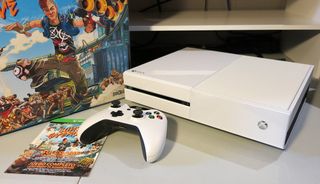
Most importantly, the Xbox One is a fantastic gaming machine. As development tools improve, Microsoft and other developers continue to narrow the gap in performance between the Xbox One and Playstation 4. More and more games achieve the 1080p resolution and 60 frames-per-second benchmark that stat-obsessed gamers (much more than the general masses) crave.
This year, Xbox One owners can choose from a highly competitive assortment of AAA exclusive games, including Halo: The Master Chief Collection, Forza Horizon 2, Sunset Overdrive, Titanfall, and "Game of the Year Editions" of last year's big launch games. Throw in third-party retail games and the ever-growing lineup of ID@Xbox games and the Xbox One already has more than enough games to keep players busy throughout the next year of the console's life.
If you're looking for a new-gen console gaming experience and you enjoy the Microsoft and Xbox Live ecosystems, now is a great time to jump in with Xbox One. Amazon shoppers can support Windows Central by ordering any of the holiday bundles from the links below:
- Xbox One Assassin's Creed Bundle – $349.99 – Amazon Link – Amazon UK Link
- Xbox One Assassin's Creed Bundle with Kinect – $449.99 – Amazon Link – Amazon UK Link
- Xbox One Sunset Overdrive Bundle – $349.99 – Amazon Link – Amazon UK Link
- Xbox One Call of Duty Bundle – ~$499.99 – Amazon Link
Paul Acevedo is the Games Editor at Windows Central. A lifelong gamer, he has written about videogames for over 15 years and reviewed over 350 games for our site. Follow him on Twitter @PaulRAcevedo. Don’t hate. Appreciate!

